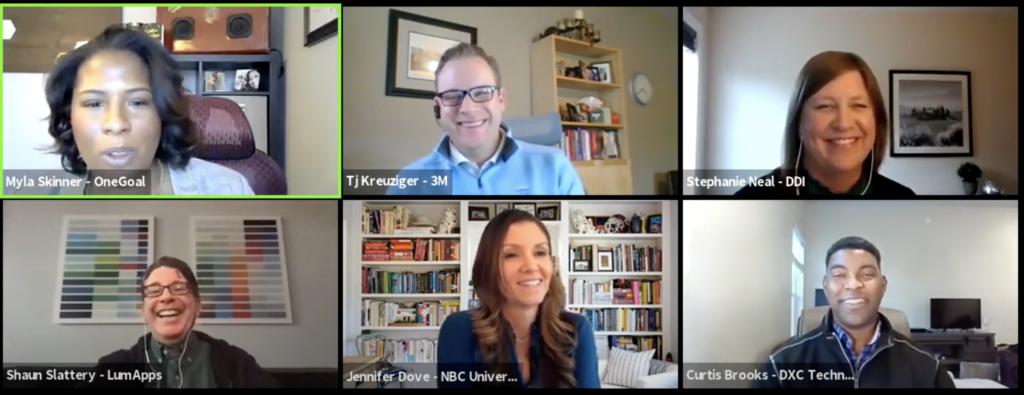Discovering the Hidden Talent in Your Own Company


For many companies, especially in the most competitive job categories, homegrown talent is more valuable than ever. So how can employers do a better job of realizing the potential of these workers by identifying, training, coaching and mentoring them–all while keeping a steady eye on diversity and inclusion?
In panel discussion about finding hidden talent within an organization, part of From Day One’s conference last week on the future workforce, moderator Myla Skinner used her own career trajectory as an example. Skinner, chief of staff at the education-advocacy organization OneGoal, described herself as “a professional product of an organization that invested in me when I didn’t even know the skills and talents that I had–and helped me grow those I had.”
It’s important for a company to define its talent philosophy as well as its career building blocks. “We want to enable employees to own their career, create paths that are flexible. We want employees to get cross-functional and cross-business experience,” says TJ Kreuziger, global leader of talent acquisition and contingent workforce solutions at 3M.
In terms of spotting employees with potential, the digitalization of the workplace has provided new tools. “I think [digital workplaces] offer fantastic new avenues not only for collaboration and engagement, but talent identification as well,” said Shaun Slattery, director of customer change management at LumApps, an employee communication and collaboration platform. “We gain visibility into skill sets and means of engagement and mentoring behaviors and things like that,” he said, which “we might not be able to witness and other means, especially in distributed work environments.”

Part of the purpose of finding hidden talent is to offer those employees a pathway to growth and advancement. “If you want to retain talent, and you want a good leadership base and a future pipeline that’s going to be diverse, it’s going to be critical that you’re building it from within,” says Stephanie Neal, director of the Center for Analytics and Behavioral Research at the leadership-consulting firm DDI.
Retention is particularly important in maintaining progress toward diversity. Curtis Brooks, principal for talent, culture and employee experience at DXC Technology and until recently a VP at U.S. Bank, recalls observing something peculiar happening in the banking company’s diversity-and-inclusion efforts. “We were good at sourcing and bringing in mid-level talent from African-American and Hispanic communities,” he said. “What we noticed is that they were leaving at a higher rate from the organization than non-Blacks and Hispanics.” The company looked at it as an opportunity to improve the system, shifting from “what” to “how” types of questions: How could they surround the individual with support, making sure they’re getting opportunities to develop? How could we give them opportunities for contact with senior leadership?
That’s where leaders step in, but it’s an acquired skill. “Only one-third of leaders will say they’re good at building talent,” said DDI’s Neal. “They recognize that they need help. It's not a natural skill for them. So I think this is really a prime opportunity for us to continue to ensure they feel–and they know–that they're the talent scouts for their organization.”
From the employee perspective, how can they find opportunities to learn new skills and apply them in new places, perhaps even internationally? Said Slattery: “The good old intranet,” which can provide a digital infrastructure for employee-resource groups (ERGs) or private online communities, where employees can come together and share resources. “We’re advising customers to have an internal job board, where you raise the visibility of opportunities,” he said. “Internal referral networks can be really important. The individual might not see [the opportunity], but the network may know.”
On that note, NBCUniversal is in the process of relaunching its internal careers site. “It’s just got a lot of new robust features and functionality and transparency. For any role that's listed at NBC, you can actually look up who the recruiter is that’s working on it with their email address and shoot them a note directly,” said Jennifer Dove, the director of talent acquisition for Peacock, NBC’s streaming platform. She noted that openings go on the internal job board 30 days before they are opened to the public. “What we're trying to encourage is maybe even a conversation that happens before someone's 100% committed to apply to the role.” Peacock went from zero employees to more than 800 in just about a year, Dove said. In recent months, almost 70% of the new hiring has drawn from current employees within the larger company.
While employers should do all they can to develop talent, ultimately employees have to find their own way. “I believe in hiring people I believe in,” said Brooks. “It is probably 90% up to the individual to identify where he or she wants to take their career, and to take the necessary actions to develop themselves in their career.”
Angelica Frey is a writer and a translator based in Milan and Brooklyn.
The From Day One Newsletter is a monthly roundup of articles, features, and editorials on innovative ways for companies to forge stronger relationships with their employees, customers, and communities.